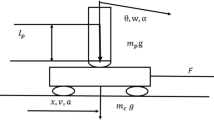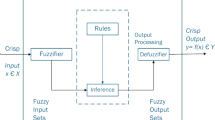Abstract
Although there are modern computational methods that we can use to solve minimum or maximum problems in different areas, it is good to use classical or semi-there are various types of membership functions. This depends on the problem to be treated. The most used are triangular, trapezoidal, Gaussian among others. For this particular case within this writing we will use the triangular and Gaussian ones. As it is already known through optimization we can come up with the best solution for a particular problem. Since this does not work for all cases in general. For this reason, we will be using in this work Differential Evolution Algorithm (DEA) to optimize a fuzzy system, for the application of this in control as a inverted pendulum system. Similarly, the proposed methodology for optimizing the system is analyzed and explained.
Access this chapter
Tax calculation will be finalised at checkout
Purchases are for personal use only
Similar content being viewed by others
References
X.-S. Yang, M. Karamanoglu, Swarm intelligence and bio-inspired computation: an overview, in Swarm Intelligence and Bio-Inspired Computation (2013), pp. 3–23
P. Gupta, R. Cambini, S.S. Appadoo, Recent advances in optimization theory and applications (2018). https://doi.org/10.1007/s10479-018-2984-yDO
D. Pamučar, D, L. Vasin, P. Atanasković, M. Miličić, Planning the city logistics terminal location by applying the green-median model and Type-2 neurofuzzy network. Comput. Intell. Neurosci. (2016)
D.S. Pamučar, D. Božanic ́, N. Komazec, Risk assessment of natural disasters using fuzzy logic system of type 2. Manag. J. Sustain. Bus. Manag. Solut. Emerg. Econ. 21, 23–34 2017
S. Sremac, I. Tanackov, M. Kopić, D. Radović, ANFIS model for determining the economic order quantity. Decis. Mak. Appl. Manag. Eng. 1, 1–12 (2018)
E.H. Mamdani, Application of fuzzy algorithms for control of simple dynamic plant. Proc. Inst. Electr. Eng. 121, 1585 (1974)
L.A. Zadeh, The concept of a linguistic variable and its application to approximate reasoning—I. Inf. Sci. 8, 199–249 (1975)
R. Kothamasu, S.H. Huang, Adaptive Mamdani fuzzy model for condition-based maintenance. Fuzzy Sets Syst. 158, 2715–2733 (2007)
S. Akkurt, G. Tayfur, S. Can, Fuzzy logic model for the prediction of cement compressive strength. Cem. Concr. Res. 34, 1429–1433 (2004)
O. Castillo, L. Amador-Angulo, J.R. Castro, M. Garcia-Valdez, A comparative study of type-1 fuzzy logic systems, interval type-2 fuzzy logic systems and generalized type-2 fuzzy logic systems in control problems. Inf. Sci. 354, 257–274 (2016)
M.I. El-Hawwary, A.L. Elshafei, H.M. Emara, H.A.A. Fattah, Adaptive fuzzy control of the inverted pendulum problem. IEEE Trans. Control Syst. Technol. 14, 1135–1144 (2006)
E. Ontiveros, P. Melin, O. Castillo, High order α-planes integration: a new approach to computational cost reduction of General Type-2 Fuzzy Systems. Eng. Appl. Artif. Intell. 74, 186–197 (2018)
L. Zheng, D. Peng, Y. Sun, S. Gao, Research of model identification for control system based on improved differential evolution algorithm, in Advanced Computational Methods in Life System Modeling and Simulation, volume 761, M. Fei, S. Ma, X. Li, X. Sun, L. Jia, Z. Su (Springer, Singapore, 2017), pp. 282–293
P. Ochoa, O. Castillo, J. Soria, Differential evolution using fuzzy logic and a comparative study with other metaheuristics, in Nature-Inspired Design of Hybrid Intelligent Systems (Springer, Cham, Switzerland, 2017), pp. 257–268
P. Ochoa, O. Castillo, O, J. Soria, Type-2 fuzzy logic dynamic parameter adaptation in a new Fuzzy Differential Evolution method, in Proceedings of the 2016 Annual Conference of the North American Fuzzy Information Processing Society (NAFIPS), El Paso, TX, USA, 31 October–4 November 2016, pp. 1–6
X. Zhang, X. Zhang, Shift based adaptive differential evolution for PID controller designs using swarm intelligence algorithm. Clust. Comput. 20, 291–299 (2017)
H. Beirami, A.Z. Shabestari, M.M. Zerafat, Optimal PID plus fuzzy controller design for a PEM fuel cell air feed system using the self-adaptive differential evolution algorithm. Int. J. Hydrogen Energy 40, 9422–9434 (2015)
M. Salehpour, A. Jamali, A. Bagheri, N. Nariman-zadeh, A new adaptive differential evolution optimization algorithm based on fuzzy inference system. Eng. Sci. Technol. Int. J. 20, 587–597 (2017)
D. Pamučar, S. Ljubojević, D. Kostadinović, B. Đorović, Cost and risk aggregation in multi-objective route planning for hazardous materials transportation—A neuro-fuzzy and artificial bee colony approach. Expert Syst. Appl. 65, 1–15 (2016)
M. Konar, A. Bagis, Performance comparison of particle swarm optimization, differential evolution and artificial bee colony algorithms for fuzzy modelling of nonlinear systems. Elektron. Elektrotech. 22, 8–13 (2016)
M. Dell’Orco, M. Marinelli, M.G. Altieri, Solving the gate assignment problem through the fuzzy bee colony optimization. Transp. Res. Part C Emerg. Technol. 80, 424–438 (2017)
O. Castillo, L. Amador-Angulo, A generalized type-2 fuzzy logic approach for dynamic parameter adaptation in bee colony optimization applied to fuzzy controller design. Inf. Sci. (2017)
J.S.R. Jang, C.T. Sun, E. Mizutani, Neuro-fuzzy and soft computing: a computational approach to learning and machine intelligence, Prentice Hall, Upper Sadler, NJ, USA (1997)
L. Amador-Angulo, O. Mendoza, J. Castro, A. Rodríguez-Díaz, P. Melin, O. Castillo, Fuzzy sets in dynamic adaptation of parameters of a bee colony optimization for controlling the trajectory of an autonomous mobile robot. Sensors 16, 1458 (2016)
R. Martínez-Soto, O. Castillo, L.T. Aguilar, Optimization of interval type-2 fuzzy logic controllers for a perturbed autonomous wheeled mobile robot using genetic algorithms. Inf. Sci 179(13), 2158–2174 (2009)
G.M. Mendez, O. Castillo, Interval type-2 TSK fuzzy logic systems using hybrid learning algorithm, in The 14th IEEE International Conference on Fuzzy Systems, FUZZ’05 (2005), pp. 230–235.
P. Melin, C.I. González, J.R. Castro, O. Mendoza, O. Castillo, Edge-Detection method for image processing based on generalized Type-2 fuzzy logic. IEEE Trans. Fuzzy Syst. 22(6), 1515–1525 (2014)
C.I. González, P. Melin, J.R. Castro, O. Castillo, O. Mendoza, Optimization of interval type-2 fuzzy systems for image edge detection. Appl. Soft Comput. 47, 631–643 (2016)
C.I. González, P. Melin, J.R. Castro, O. Mendoza, O. Castillo, An improved Sobel edge detection method based on generalized type-2 fuzzy logic. Soft. Comput. 20(2), 773–784 (2016)
E. Ontiveros, P. Melin, O. Castillo, High order α-planes integration: a new approach to computational cost reduction of General Type-2 Fuzzy Systems. Eng. Appl. of AI 74, 186–197 (2018)
O. Castillo, Type-2 Fuzzy Logic in Intelligent Control Applications (Springer, 2012)
P. Melin, O. Castillo, Intelligent control of complex electrochemical systems with a neuro-fuzzy-genetic approach. IEEE Trans. Ind. Electron. 48(5), 951–955
L. Aguilar, P. Melin, O. Castillo, Intelligent control of a stepping motor drive using a hybrid neuro-fuzzy ANFIS approach. Appl. Soft Comput. 3(3), 209–219 (2003)
P. Melin, O. Castillo, Adaptive intelligent control of aircraft systems with a hybrid approach combining neural networks, fuzzy logic and fractal theory. Appl. Soft Comput. 3(4), 353–362 (2003)
P. Melin, J. Amezcua, F. Valdez, O. Castillo, A new neural network model based on the LVQ algorithm for multi-class classification of arrhythmias. Inf. Sci. 279, 483–497 (2014)
P. Melin, O. Castillo, Modelling, Simulation and Control of Non-linear Dynamical Systems: An Intelligent Approach Using Soft Computing and Fractal Theory (CRC Press, USA and Canada, 2002)
P. Melin, D. Sánchez, O. Castillo, Genetic optimization of modular neural networks with fuzzy response integration for human recognition. Inf. Sci. 197, 1–19 (2012)
M.A. Sanchez, O. Castillo, J.R. Castro, P. Melin, Fuzzy granular gravitational clustering algorithm for multivariate data. Inf. Sci. 279, 498–511 (2014)
D. Sanchez, P. Melin, Optimization of modular granular neural networks using hierarchical genetic algorithms for human recognition using the ear biometric measure. Eng. Appl. Artif. Intell. 27, 41–56 (2014)
Acknowledgements
We are very grateful to CONACYT (National Council of Science Technology). It is also very important to mention the TecNM (National Technological Institute of Mexico) and Tijuana Institute Technology.
Author information
Authors and Affiliations
Corresponding author
Editor information
Editors and Affiliations
Rights and permissions
Copyright information
© 2021 The Editor(s) (if applicable) and The Author(s), under exclusive license to Springer Nature Switzerland AG
About this chapter
Cite this chapter
Ortiz, V., Castillo, O., Cortés-Antonio, P. (2021). Optimization of Fuzzy Systems Through Metaheuristics in Control Systems. In: Melin, P., Castillo, O., Kacprzyk, J. (eds) Recent Advances of Hybrid Intelligent Systems Based on Soft Computing. Studies in Computational Intelligence, vol 915. Springer, Cham. https://doi.org/10.1007/978-3-030-58728-4_17
Download citation
DOI: https://doi.org/10.1007/978-3-030-58728-4_17
Published:
Publisher Name: Springer, Cham
Print ISBN: 978-3-030-58727-7
Online ISBN: 978-3-030-58728-4
eBook Packages: Intelligent Technologies and RoboticsIntelligent Technologies and Robotics (R0)




